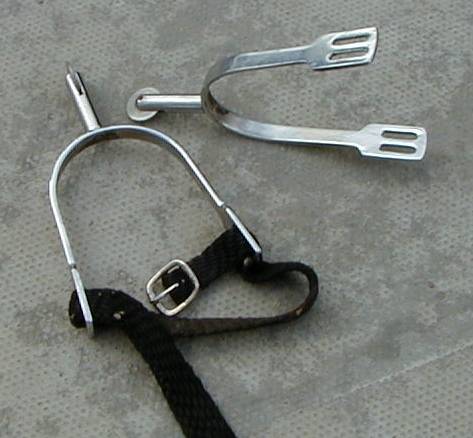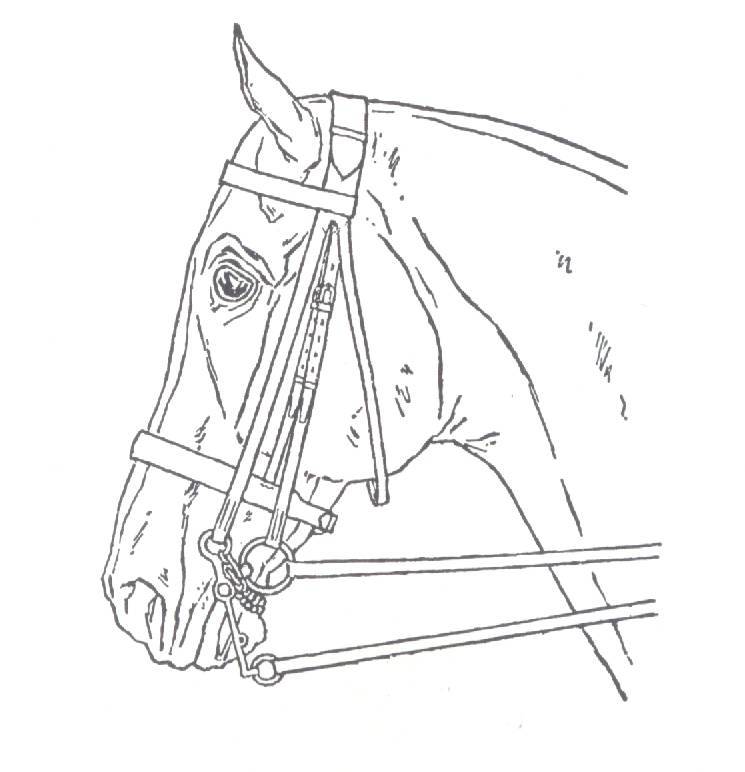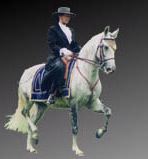 |
classicaldressagescotland.com |
| Lesson 17: The Spurs and Double Bridle (Full Bridle) |
| New web address: www.classicaldressagescotland.com |  |
| About this site | About us | Personal Tuition | Video analysis | Lesson menu | Portugal and Lusitanos |
| Home Schooling Classical dressage Modern dressage Horse trials Show jumping Glossary Links |
I often get e-mails from the members asking when and why they should use spurs and a double bridle. For example what age should a horse be before a double bridle can be used? When shall I use spurs? etc. This lesson hopefully will give you some idea. I will start with some thoughts on spurs. Using spursThe first questions you must ask yourself before using spurs are:
If the answers to questions 1 and 2 is no and yes to number 3, then it will be too early for you to use the spur. If when you ride your horse you whack him at every stride with the long whip you would expect your horse to be initially upset and after a time completely dull, dead to the leg and whip and resigned to the discomfort of you, the rider, hitting him for no good reason. Obviously this is totally unacceptable. You would deserve to be pulled off your horse, sat on by an extremely large all-in wrestler and beaten repeatedly with a whip to see how you liked it! Think about it, if you do not have control of your legs and you are digging your spur into you horse at every stride for no good reason, what's the result? You will damage your horse's confidence, cause him/her undeserved discomfort and ruin any relationship and respect you might have had up to that point with your horse. If you are in any doubt as to whether you are capable of using a spur with finesse, subtlety and prudence, seek the advice of an expert, a trainer whom you trust, who can watch you and give you his or her opinion as to whether spurs would be appropriate to use at your stage of riding and training. It goes without saying that spurs should never be used to injure a horse, and any style of spur capable of wounding a horse must be totally wrong. Also I must say here that bludgeoning a horse with dull or "small humane" spurs is also totally unacceptable. Bear in mind that if your spurs are too short you will have difficulty feeling them when you use them against your horse's side. I don't like these little diggy things you can buy in the UK. There is a belief that the smaller the shank of the spur, the more humane they are. This is nonsense. If they are too small the rider has to bring the toes so far away from the horse's side to use the spur that the rider's position has to be compromised. Also if the rider habitually grips with the knees and kicks with the lower leg, it will only be the horse that knows the spur has been applied. The length of the shank should be long enough so that the spur can be felt by both horse and rider but not too long that there is no room for error if the rider moves, even slightly, and touches the horse's side with the spur by mistake. Think of spurs as a sculptor would use his chisels. He would use a finer, smaller chisel to refine his work and bring out the beauty of the piece. Spurs are not implements of torture or crudity: they are designed to engender more sophisticated feel and response in both horse and rider. As you progress and start to ride the more advanced dressage tests, (medium and above) you will find that wearing spurs will be mandatory. By this stage the horse must be so acclimatized to, and trusting of the rider's leg aids that use of spurs can be nothing but refinement and a back-up for your normal, light, subtle, almost invisible leg aids. If however there is a problem with using spurs, something fundamental has gone wrong with the training. You must find out what and if necessary go back to basics.
The double bridleFirst of all what is a double bridle? The double bridle consists of two parts, the curb bit and the snaffle
or french bridoon. The curb consists of the curb chain, the headpiece and
the cheekpieces onto which the curb bit is fastened. The snaffle or french
bridoon also consists of the head- and cheekpieces.
The FittingThe important effect is that of the curb which will depend on the thickness of the mouthpiece, the size of the port, and the proportion of the upper cheek to the lower. The effect can also be varied by the adjustment of the curb chain. The size of the horse's mouth must be measured; if the bit is too narrow the lips of the horse will be pinched, which will cause pain and his lower jaw will not move freely. If, on the other hand the mouthpiece is too wide, it will slip from one side to the other with the action of the reins and interfere with their effect. Beside which, the curb chain would not lie steady on the chin groove. It is important to remember that the severity of the mouthpiece is directly proportional to the thickness of the bit. The thinner it is the sharper it will be. Therefore, a thin mouthpiece should be selected for a horse with fleshy bars and a thicker one for horses with more sensitive bars. The size of the port must be chosen with some thought. The port is there to give freedom to the tongue, so the size of the tongue must be considered. A low or small port is suitable for a horse with a thin tongue and obviously a larger port for a horse with a king-size duvet in his mouth. The effect of the curb becomes more severe as the height of the port is increased. For a dull horse with a hard mouth, a thin mouthpiece and high port should be used, but the rider must always remember that the correct position of horse's head should be obtained by correct early training and not by use of the curb bit. When selecting the mouthpiece of the curb bit, the proportion between the upper and lower cheeks has to be taken into account. The cheeks work as a lever and can cause a lot of damage to the horse's mouth and confidence if you get the selection wrong. The shorter the upper cheek in proportion to the lower, the sharper will be the effect. The nearer equal in length the upper and lower cheeks are to each other, the milder will be the bridle. As a general rule the lower cheek should be twice as long as the upper. The action of the curb will depend on the chain and its power will depend on its adjustment. The chain, therefore, is of greater importance than is often thought. A horse will generally yield to pressure. This is the case with the snaffle, but it is much more so with he curb, the power is increased by its lever-like action. This action will be possible only when the curb chain holds the mouthpiece so that it will exercise a pressure on the curb groove. It's important that the chain is fitted and twisted correctly. Note: to twist the chain correctly attach one end to the off side hook on the curb. Take the other end of the chain under the chin and turn the chain clockwise. Keep turning clockwise until you feel resistance and cannot turn any more without kinking the chain. Attach the end to the near side hook on the curb so that the hook maintains the pressure of the clockwise turning motion. The horse will always yield to the stronger pressure, so that if the curb chain is the stronger, he will throw his head up and lose contact instead of lowering his head by responding to the pressure on the bars of his mouth. Therefore, a horse with a sensitive skin or is sensitive under the chin should have a curb chain with large flat links, or one fitted with a leather or rubber curb guard. Trial and error comes into play here and one must experiment. The curb chain should lie evenly over the whole chin and not just touch it in places, as would happen if the mouthpiece was too wide and the first links, attached to the curb hooks, do not make contact with the chin. The chain length is important: when correctly adjusted you should be able to put your finger between the chain and the horse's chin while the curb cheekpieces are in line with the bridle headpiece. As you take a contact with the reins and pull back on the curb you should just feel pressure on your finger. A curb chain that is too loose would be the lesser fault and sometimes is advisable when using a curb for the first time with a sensitive horse. Be aware however that if the chain is too loose you will lose the effect of the tongue port because the curb cheeks will be able to come too far back and flatten the port. The cavesson nose band completes the double bridle or full bridle. This must be fitted sufficiently high so that the horse's lips are not pinched between the bit and the noseband. I like to use reins that are completely different from each other. For example I like the snaffle reins to be plaited and the curb reins to be completely plain. The reason I prefer this feel in my hand is that when you are riding and concentrating on your schooling or even riding a competition, it's paramount that you have the correct reins in the correct part of the hand. You must be aware where each bit is in relation to the reins in your hands. It would be a disaster if you thought the snaffle reins were really the curb reins and visa versa. Always remember that "The more metal in the horse's mouth, the more the rider lacks the art of riding" When to fit the Double BridleThis is always a difficult question to answer. There are several considerations that must be taken into account before you fit the double.
Let's take these questions one by one
Introducing the double to your horseI remember years ago while hunting I was in company with two extremely portly gentlemen. Both their horses were big and powerful and were obviously expensive but one was calm and relatively under control while the other rider was having a real problem keeping his horse from bolting. By the time I caught up with them, a couple of hounds had been squashed and the master was threatening a lynching if he and the rest of the field were passed again. What really annoyed the gent with the naughty horse however was that his mount would not give him time to get his sloe gin out of his saddle flask and into his mouth. The gent with the calm horse was using a double bridle and the huntsman with the bolter was using a straight bar snaffle. There in the middle of the hunting field they decided to swop/exchange bits and bridles in the vain attempt to calm the naughty horse. Of course the calm horse remained calm but I must admit I have never seen a horse go so fast backwards. And when the horse did decide to go forwards it put its head between its front legs and passed the hunt followers, the hounds, hunt servants and the master and was last seen on the M2 motorway with two police cars in hot pursuit. The moral to this story. Preparation is everything. No horse should be expected to work in a double bridle until he has received some hours of quiet introduction. That introduction should initially take place in the stable, to be followed a day or so later by several short periods of quiet riding, first in walk and later in trot, on more or less in straight lines, with only brief and occasional contact with the curb rein. The introductory phase - much of it taking place at halt, walk and occasionally trot - is important. It gives time for both parties to feel and to test their own and each other's reaction to the new piece of equipment. The horse gains confidence despite the added power of the curb and that it is not being used to hurt or bully him. But above all else, he will learn from the experienced rider that a ready submission will bring immediate softness and give/release from the bit pressure. The rider will be learning that he or she now has two sets of reins and control of two bits and that he/she must act accordingly and never grab the reins in such a manner that the two bits act together on the bars of the horse's mouth in a crude and hard way. If you run out of patience or forget to go through the above introduction you could ruin your horse's mouth and consequently make all your previous training worthless. The Action. What does each bit do?The bridoon, or snaffle, in a double provides, just like your ordinary working snaffle, the basic means of contact and control by the reins. It should never vary in its action. The result is that the horse comes quickly to accept its stability and simplicity, and is not afraid when he is asked for more impulsion or to go more forward. It forms the permanent bond between horse and rider that should never be broken. The curb bit has the sole function of reminding the horse, through its lever action, to keep the jaw relaxed and consequently sensitive to the light action of the rider's hands. The mouthpiece of the bit achieves this by its slightly downward pressure on the bars of the mouth as it pivots round the fulcrum of the curb chain. The mere weight of the curb bit, together with the weight of the leather rein will itself effect a gentle pressure all the time, even when the rider is not putting any pressure on the curb rein. The weight of the bit, gravity and the position in front of the vertical of the horse's head will see to that. Such pressure will be lighter than the lightest action of the hands, so give the curb bit a chance to be self-operating. Only if the horse starts to neglect the curb should the rider bring his/her fingers into play and take some contact with the curb rein to bring pressure on the bars. As soon as the horse yields or softens, respond by releasing the fingers and allowing once again the curb to be self-operating. Never keep the pressure constant on the curb. You will create numbness and resistance. This sentence is worth repeating. As soon as your horse responds to the curb, back off, release, give and above all FEEL what's happening with your horse's mouth. You the rider must always be aware of which combination of the two bits you are using at any given moment, and of the reason for the choice. But always remember the bridoon or snaffle should not be lessened or hardened just because you have used the curb. Remember the snaffle is the predominant bit and should be used as you would use your horse's normal working snaffle. Holding the ReinsThere are numerous ways to hold the reins and it is up to you, the rider, to experiment and to discover which is best for you and your horse. I will give you a few examples below but in the end its up to you to find out what suits Dobbin and yourself. Just for simplicity I will number the fingers so you will understand what fingers I am talking about.
The following is the method I use.
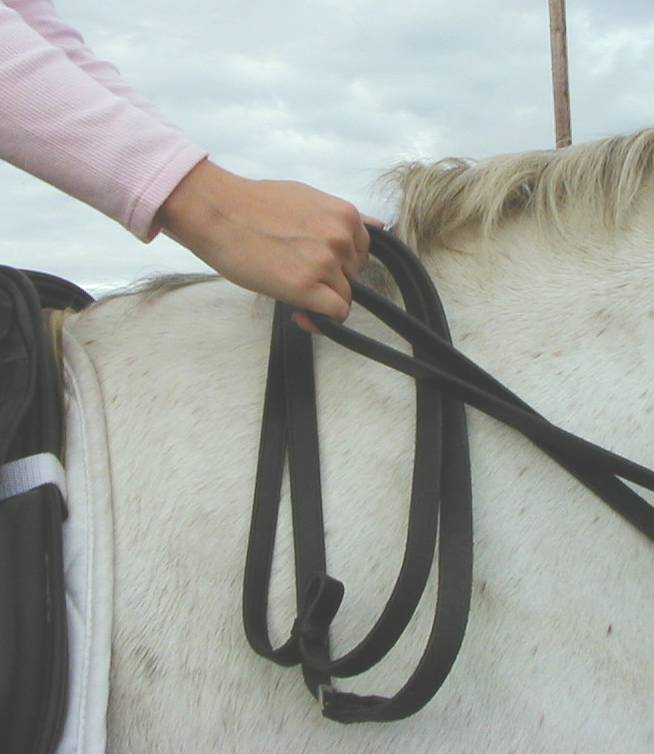
Why do I use this method? I just find it easier. I like to feel the snaffle rein underneath my hand. It gives me a more positive feel of the snaffle, which as I said above is really important. I also like to feel two fingers separating the reins and find in easier to pick up the reins after I have just saluted and taken off my hat for the judge. Sometimes when the pressure is on during a competition, its difficult to take the reins and the whip in one hand, your hat in the other, and make sure you have put your hat back on properly. Nothing is quite so embarrassing as you're topper slowly tipping to one side or falling off backwards during extended trot. Girl/lady riders ignore this bit, you guys just have to nod. You don't know how lucky you are. This method is the most popular.
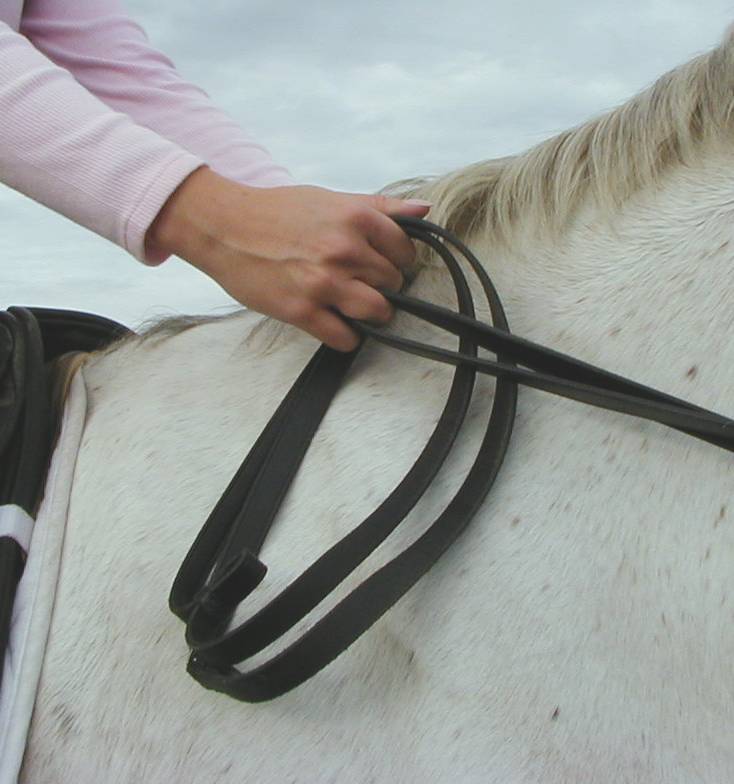
The snaffle rein is underneath your normal snaffle finger - finger 3 - so this way of carrying the reins will feel normal and less of a cultural shock to most riders. Unfortunately this method only has one finger separating the curb and the snaffle reins. For me that's a problem but it might be OK for you. The Fillis method.
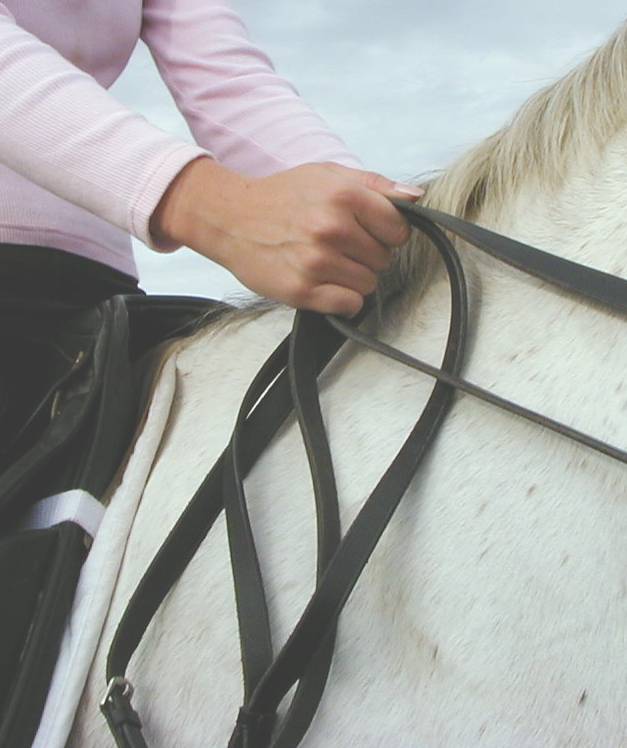
This method is really strange but it might help you to understand what each rein does. This way of holding the reins was invented by a Colonel Fillis who I understand was an Englishman who was riding master in the Czars court in Russia during the 19th century. I occasionally use this to teach clients the power of the double bridle and how important it is to separate the action of the two bits. The Spanish Riding School method.Right hand
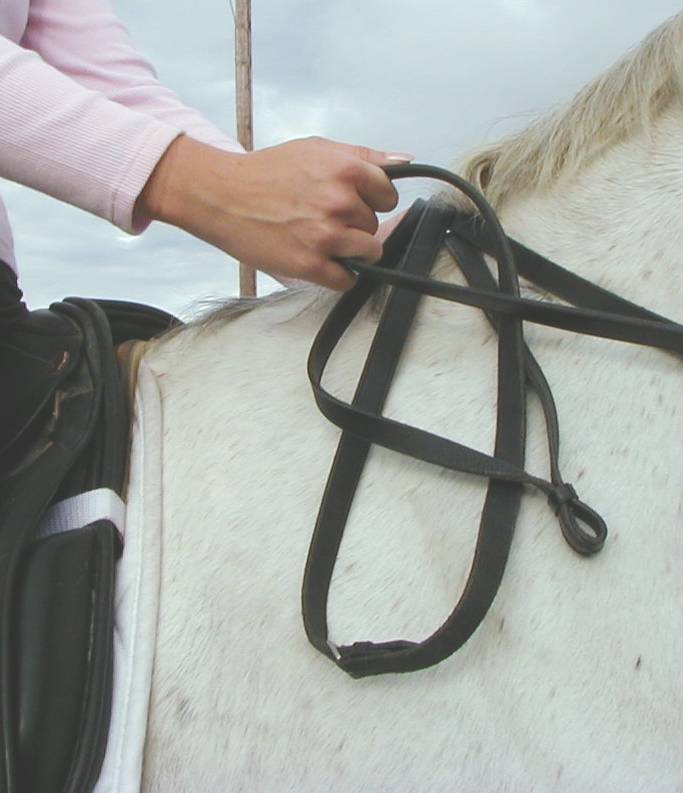
Left Hand
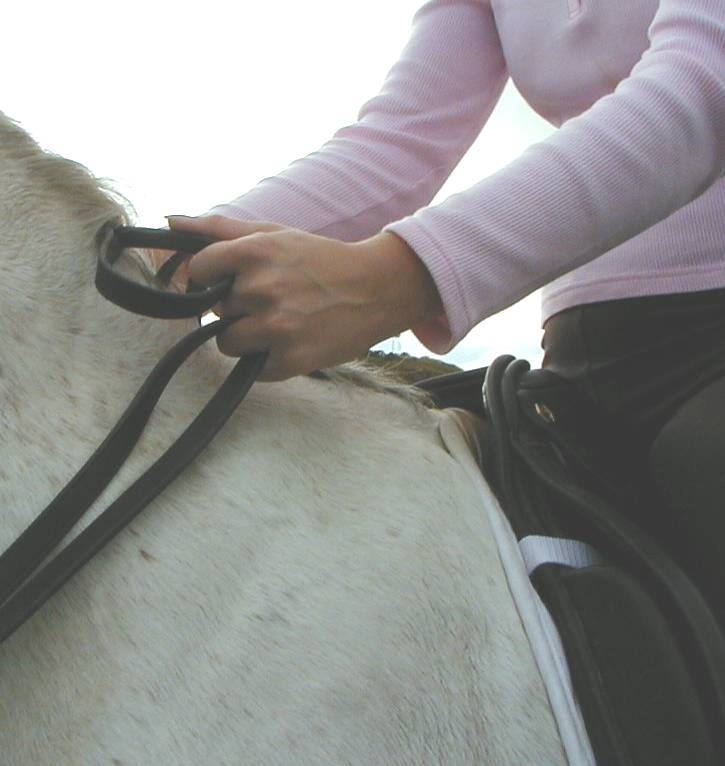
If I have a horse that needs no contact with the curb at all except its natural weight and is totally secure with this contact, then I will use this method. This way of holding the reins is also good for the male rider because it's easy to put the single rein in the left hand to doff the hat. In ConclusionThe double bridle is a great tool if used correctly. If you have done your homework and prepared properly it will give you and your horse a far greater degree of lightness. However if you have put all this machinery into your horses mouth without any thought or consideration you will get into trouble with your training. In good hands the double is a great boon and aid for lighter and beautiful riding. A double in bad hands is just plain cruel. As always I will finish by quoting the great master Nuno Oliveira: "The mouth of the horse is one of the most sensitive parts of his body. Nowadays the rider believes that the horse is trained only by the engagement of the hindquarters and that that is sufficient to have a good mouth. Of course we must engage the hindquarters with clever gymnastic exercises, and by the use of these exercises we must activate the hindquarters. But at the same time we must understand how the mouth moves and functions. A simple snaffle can be a very hard bit when the horse is fighting against it, and a double bridle can be very soft if it is used with an experienced hand, and the horse gives under the action of that experienced hand. Especially, we must not forget that the mouth of the horse is placed, as is his brain, in his head." If you have any queries or problems with the lesson, please give a call. If you don't e-mail me I will never be able to help you. Enjoy your horse and try smiling a bit more when you're training your horse. You will be amazed how powerful you smiling muscles are!!!!
|
